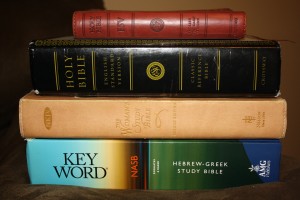Last year I worked at a popular Christian bookstore chain. We were asked more questions about Bible translations than anything else.
“What are the differences in all these translations?”
“Why are there so many different Bibles?”
“How do I know which one to get?”
Here’s the basic information about different Bible translations and how to choose the best one for you!
The types of Bible translations are referred to as “word-for-word” and “thought-for-thought.” Word-for-word translations try to remain as close as possible to the early manuscripts. Thought-for-thought translations seek to communicate the original thoughts of the biblical writers.
Here are the most popular versions on a scale, beginning with word-for-word, and moving to thought-for-thought:
Word-for-word
- New American Standard Bible

- English Standard Version
- King James Version
- New King James Version
- Holman Christian Standard Bible
- New International Version
- God’s Word Translation
- New Living Translation
Thought-for-thought
(The Message is a paraphrase version of the Bible, not a translation.)
When choosing which translation of Bible is right for you, consider these questions,
- Will I be using this Bible for devotional reading? If so, you may want an easier to read, thought-for-thought translation.
- Will I be using this Bible for inductive study? If so, you may want a word-for-word translation.
- Will I be taking this Bible to church? If so, what version does your pastor use? You may want to get the same one so it’s easier to follow along.
- Will I be using this Bible to teach others? If so, you may want to pick a popular translation so more people in your audience will have the same version.
- Will I be using this Bible with my children or to teach children? If so, consider getting a translation that is easier for children to understand. (Two translations specifically for children are the New International Reader’s Version and the International Children’s Bible.)
Knowing what you will use your Bible for and understanding the types of Bible translations will help you choose the right Bible translation for you.
What’s your favorite Bible translation? Why do you like it?

I grew up on the NAS, and really loved my Key Word Study Bible, especially before so many online resources became available and known to me.
Now, I use the ESV and love it. Have the ESV Study Bible, which is great! It has an online version, too. So, I love having all of t he study notes and charts at my fingertips, on my iPad or computer.
My favorite phrase-for-phrase version is the NLT. I had a little pocket version I used al the time in college ministry, while I was on campus. I also like to use it for a fresh look at the really familiar passages.
Great post, thanks!
What a practical post! Thank you… I am asked this question also and am glad to have this concise explanation to direct folks to.
I’ve been trying to figure out how to pick another bible. I have a NLT devotional, NIV Study Bible, HCSB Apoligetics Student bible, NSRV that is what we use at church. I’ve been looking at getting a NKJV Study Bible (or a bigger print NIV Study Bible, but Idk if I want the older or the new 2011 translation.)
I enjoy “switching” every so often, so that I stay alert to the different words and styles of the versions. It can made memorization a little challenging, at times, but even that forces me to really study the word choice. I’ve used the NAS, NIV, NKJV, and am currently in an ESV season. Also enjoy using some other non-word for word versions as complements to my devotional time.
Same here Julie!…except for the NKJV, I never got a hold of one of those. =p Having the different versions available makes really digging into His Word a little easier, but I totally agree with the memorization part of it.
This is a fabulous resource! I used several of the word-for-word translations you’ve listed. My favorite is NLT and I also used the Amplified quite a bit, too when I need better understanding. I keep a KJV for church because that’s what’s used there.
I am currently using the ESV for study and the NIV for devotional and group time. I am really enjoying the ESV!
I love this, Sandra! The list of questions is a great way to help determine what translation will work best for you. What a great post!!
As you know, I love the ESV and the NLT.
Indeed a great list to check against which version to use/get.
I use the ESV and NLT at home; our church uses the NIV version at this time.
I love how you described the “word-for-word” and “thought-for-thought” continuum, Sandra. We use the NIV and ESV the most in our home, though we reference often to the NIrV (interesting to reference to as an adult, along with reading it to our kids!) and the NLT.
Very helpful post. Thank you for the succinct information. I have used my favorite Bible for years which is NIV. I do like to read NASB when doing inductive study, and NLT to enjoy different wording of familiar passages.
I’d love to share this helpful post, but I think your list might have gotten skewed somehow, since you don’t have any translations under the “Thought-for-Thought” heading. Could you check and correct if necessary? Thanks!
Hi Diane! There aren’t two lists, it’s one list moving from word-for-word to thought-for-thought. Hope that helps!
Hi Sandra! Yes, I see that now. I read the post too fast. Thanks and blessings–Diane
What’s wrong with the NRSV?